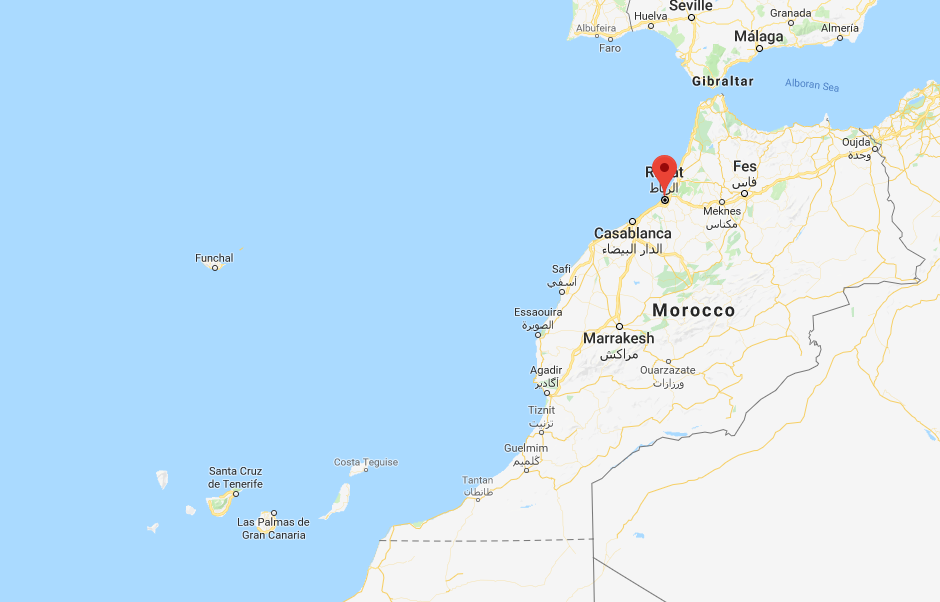Summary:
- The African Development Bank Group (ADBG) to support expansion of Rabat Salé International Airport with EUR75 million in financial support;
- The capital's airport plays second fiddle to nearby Casablanca, Agadir and Marrakech but passenger traffic is growing;
- The bulk of the financial assistance will probably go towards expanding the cargo terminal with plans to quadruple the airport's passenger freight capacity.
Morocco is a country of almost 36 million people but Rabat, the capital, is only the seventh largest city, with a population of just 575,000, growing to 1.2 million when you consider the wider metropolitan region. Casablanca is the largest city, with a population of 3.36 million (6.8 million across metro area) and the biggest city in the Maghreb region.
MAP - Rabat and Casablanca are actually only 87 km (55 miles) apart along Morocco's Atlantic Ocean coast and that proximity goes some way to explaining Rabat's - and its airport's - minor role Source: Google Maps
Source: Google Maps
Casablanca is one of the most important cities in Africa, both economically and demographically. It is Morocco's chief port (one of the largest artificial ports in the world), the economic and business centre for the country and one of the largest financial centres on the entire continent.
The leading Moroccan companies and international corporations doing business in the country have their headquarters and main industrial facilities in Casablanca and the city retains its historical position as the main industrial zone of the country as well as being the primary naval base.
Casablanca is now developing a tourism industry, though not so much beach and sun-oriented as found in and around Agadir, 200 km to the southwest, but in golf, gastronomy, shopping and night life.
With beach resorts along the Atlantic Coast, the ancient city of Marrakech and Casablanca just up the coast, Rabat has much to contend with but, it has a tourism offer of its own. It has been highly ranked by CNN as one of the top travel destinations in the world and parts of the city are a World Heritage Site.
Passenger traffic at Rabat Salé International Airport has been rising consistently yet erratically over the last six years, peaking at +40.9% (2014) then falling to +3.2% the following year. There were 925,000 passengers in 2017 and year-on-year growth in the first nine months of 2018 is +3.5%. There is no obvious reason for these peaks and troughs. Although Morocco generally is considered "at risk" from terrorism the last serious attack took place in 2011.
CHART - Rabat Salé International Airport is seeing growth, but annual rates have varied significantly this decade Source: CAPA - Centre for Aviation and Morocco Office National Des Aéroports
Source: CAPA - Centre for Aviation and Morocco Office National Des Aéroports
It is probably more to do the commencement of flights by Ryanair in Nov-2013 and the impact of the 10 routes its flew in 2014. Ryanair is currently the largest airline in Rabat with 37.9% of capacity and 44.3% of (peak) movements, followed by Air France. Rabat can marginally be defined as a 'low-cost' airport with LCCs accounting for 55.5% of seats.
The last new construction exercise was the Terminal 1 building, which was inaugurated in Jan-2012. It is 16,000 sq m and has a maximum capacity of 3.5 million ppa, twice that of the old terminal.
It is not evident yet how this ADBG largesse will be apportioned. According to the CAPA - Centre for Aviation Airport Construction Database, ONDA, the government airports authority, outlined plans a year ago to develop Rabat Airport and expand its capacity in a project expected to commence in 2018. The project is expected to increase capacity to more than four million ppa.
But it is the cargo sector where the biggest opportunities are thought to exist. There was a dramatic increase in capacity - over 80% - in 2016 and the level (around 13-14 million kg per annum) has been maintained since. the freight segment could be the main recipient of the funds with a possible extension of the cargo terminal, which currently covers an area of 1360 sq m.